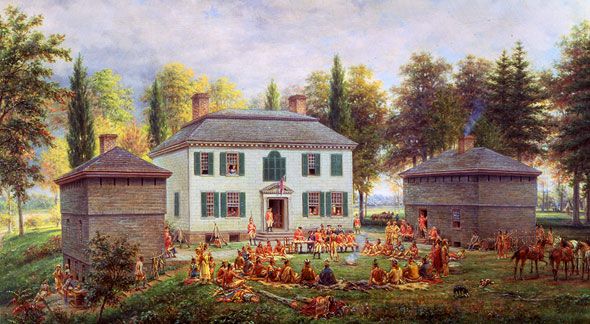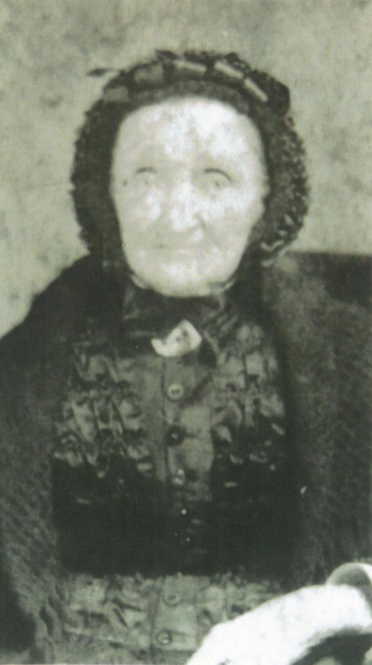A review and more, by Sherry Johnson
I chased down this book a few years ago, while researching the first wife of Joel Stone, the founder of Gananoque. I didn’t find anything new about her in the book, but it seemed sensible while I had a copy to at least skim the whole before sending it back. What a fascinating read it turned out to be! A few years later, when I ran across a secondhand copy, I dithered about the purchase, as it was well beyond the budget for research reference books at the time. I didn’t take it, but I guess my excitement about seeing a copy for purchase showed, since my father and hubby presented me with it.
Potter-MacKinnon gives an amazing view of the travails of Loyalist families, especially the women and children. My maternal family line has Loyalists and Americans, so you’d think I’d have explored the reality of that life. NOPE! Like many of Loyalist heritage, I just accepted the fact that my ancestors chose to support the British and didn’t consider what that had meant in disruption to their lives. Lives recently built in a wilderness, at a cost, often a huge cost.

This 216 page book, with its detailed accounts of the price paid by Loyalists, settlers, and Indigenous people, presents in an interesting and very readable way, the cruelty of a struggle that split families, as well as the strength of the family and of women at the time. The stories of Joel Stone, Sir John Johnson, and Molly Brant were of particular interest to me as they belong to the Thousand Island area. I was already telling their stories when I had an interested audience, which I am going to assume you are.
In the early 1790’s, the first two land grants that became Gananoque went to Loyalists Joel Stone and Sir John Johnson. They wanted not just rights to the land here, but also access to the protected harbour where the Gananoque River joined the St Lawrence. Most importantly, they wanted the rights to the power the Gananoque River could generate.

So important was the river that their grants were defined by the middle of it. Interestingly, it may not be the first time rights had been defined that way. The Mississaugas were loath to cross the Gananoque River as it was the boundary between their lands and those of the Iroquois. Sir John Johnson got the larger original land grant of 1,000 acres on the east side of the river. Once he built the first grist mill and installed a manager, he did little that affected Gananoque’s history. Joel Stone, granted 700 acres on the west side of the river, was truly a founding father. In the first couple of years here, Joel and a group of skilled, ambitious tradesmen he selected, built grist and lumber mills with dams and canals to serve them. Gananoque actually grew from the needs of developing industries, not from the needs of homesteading settlers.
History has kept Koñwatsi'tsiaiéñni in view, unlike so many in our past who come from a marginalized group or groups. Both Indigenous and a woman, her story could have been left undocumented and hidden, but it was not. Worthy of a Canadian stamp in 1986, celebrating her as both Koñwatsi'tsiaiéñni and Molly Brant. An Elder of her people, and the Six Nations Matrons, she was part of a group of Indigenous people living in peace with settlers in the Mohawk Valley, New York. Many of those settlers, as Loyalists, ended up settling in the Kingston area. My respect for Koñwatsi'tsiaiéñni comes from the fact that she seems to have been able to retain her identity, while keeping a foot in two separate worlds. She had affiliations with the Anglican Church and the respect of many in Kingston society at the time, while maintaining a position of respect with her people. A difficult thing to do at all and yet she seems to have done it exceptionally well. In writing, I call her Koñwatsi'tsiaiéñni; verbally I have to use her English name Molly Brant, as I have not yet managed to wrap my tongue around Koñwatsi'tsiaiéñni.

McGill-Queen's University Press published the hardcover version of this book in 1993 and a soft cover version in 1995. Used copies are available from Amazon.ca and, as I discovered, can be stumbled upon in local second hand book locations. It is likely still available through the libraries in Kingston.
So, here’s to celebrating our loyalist ancestor’s stories! Some we know are fact, others like this one from my family, fish tales or fact? We’ll never know.

One Spring, Great-great-great-grandpa Merkley decided to do the two-day trek to buy some needed supplies. He offered to leave his wife the only gun they owned. She refused, saying I can’t, I won’t, and I don’t use guns. So off he went with the gun. While he was away, the primitive homestead was visited by a bear who was eyeing the only livestock they owned then, a pig. Feeling that the pig was one of the few things that stood between her family and starvation the next winter, G-g-g-grandma grabbed the axe and attacked the bear, driving it off, possibly killing it. Having seen some of the female relatives of this line red hot, blind angry, I can well believe that they would tackle a bear with an axe!
By Sherry L. B. Johnson
Sherry Johnson lives in Gananoque and is a writer and researcher for GanWalking. Home is a “handyman special” under slow improvement, with things like solar panels and heat pumps a priority. Retired from food service and hospitality, Sherry says she has, "become one of those old ladies you watch to see what she’s going to get up to next."
Be sure to see Is the Architect as Interesting as His Architecture?, December, 2022.
Posted in: Volume 18, Issue 2, February 2023, History, Book review, Places, People
Please click here if you are unable to post your comment.
